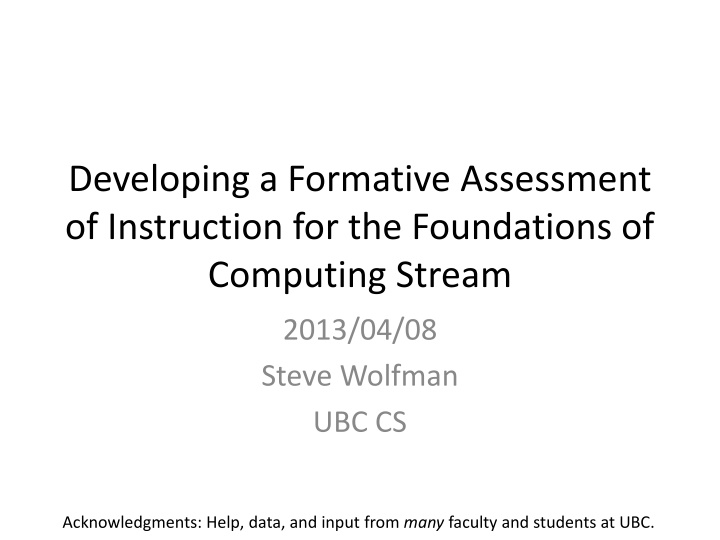
Developing a Formative Assessment for Computing Instruction
Explore the process of creating a formative assessment for computing instruction, focusing on sustainable assessment practices and key learning goals such as recursive thinking, problem formalization, and meta-cognitive skills. Learn about methodology, assessable goals, and the importance of validating expert and student responses in the assessment process.
Download Presentation

Please find below an Image/Link to download the presentation.
The content on the website is provided AS IS for your information and personal use only. It may not be sold, licensed, or shared on other websites without obtaining consent from the author. If you encounter any issues during the download, it is possible that the publisher has removed the file from their server.
You are allowed to download the files provided on this website for personal or commercial use, subject to the condition that they are used lawfully. All files are the property of their respective owners.
The content on the website is provided AS IS for your information and personal use only. It may not be sold, licensed, or shared on other websites without obtaining consent from the author.
E N D
Presentation Transcript
Developing a Formative Assessment of Instruction for the Foundations of Computing Stream 2013/04/08 Steve Wolfman UBC CS Acknowledgments: Help, data, and input from many faculty and students at UBC.
Inspiration From Patitsas and Wolfman, SIGCSE 2012 From Mazur, Int l Newsletter on Physics Ed, Apr 1996
Ideal Goal Sustainableassessment as a thermometer for health of the courses. What makes it sustainable? Let s look at the FCI: 29 multiple choice Qs and takes 23.3 minutes Founded on previous/ongoing physics ed. research Focuses on a few key topics Deliverable on paper (if needed!) From Hestenes, Wells, and Swackhamer, Physics Teacher Mar 1992
Methodology Gather goals by interviewing faculty involved in the stream Augment & winnow goals by analysis of exam results Draft questions to assess key goals Validate expert responses to questions Collect student misconceptions in think-aloud interviews Formulate forced-answer versions of Qs based on student responses Validate forced-answer Qs in think-aloud interviews Pilot assessment, confirming reliability and validity General use for assessment of courses, longitudinal analysis, etc.
How do we assess these?? Grand Goals What are the key learning goals for the Foundations of Computing stream? Recursive/inductive thinking Analysis of resource (time, space, energy, ) costs of solutions Formalization/specification of ill-specified problems Comfort with dense formal descriptions Proposal and explanation of multiple solution approaches to a problem Meta-cognitive management of the solution process Generalizing/abstracting problems/sol n properties
to Assessable Goals (?) Think about times when you cringe inside because your students just don t get something that seems very important to you, and which you expect any expert to get. Induction (6/2/-1): should be able to do .. themselves from scratch without requiring additional input Divide & Conquer / Recurrences / Dynamic Programming (4/0/-3): express the solution to a problem in terms of subproblems + Quick review of low-/mid-/high- scoring exams. Logarithmic Tree Height (3/0/-0): How many times can I give away half my apples before being left with just one?
Exam Analysis: Low Mean For each question: average and standard deviation on the question, Strategic snippets of the worst-performing, High Correlation
the values are pointed to or stored in the same node object The value [are] stored in these bubbles the values would reside in memory or on disk So the values are.. in the nodes the values should be 1, 2, 3, 4, 5, so they're index values 6, 7, 8 an array the keys could just be the indices of a giant array [the key is] a lookup for the value the values are being represented in the tree by the keys. So knowing the key like unlocks what the value is the values would actually be in the leafs
We often draw Binary Search Trees (BSTs) like this, showing the keys but not the values: The keys in this BST are numbers; [assume that the values are as well OR assume that the values are images]. Where are the values in such a BST? Choose the best answer. (a) The values are stored in the same node as the keys. (b) The values are at the leaves. (c) The values are pointed to from the same node as the keys. (d) The keys are indices into an array that stores the values. (e) The keys point to the values. (f) The values are represented in the tree by the keys. (g) The values are 1 (for the node labeled 7), 2 (for the node labeled 4), 3 (for the node labeled 10), 4 (for the node labeled 2), and so on. (h) Not enough information to tell. (i) I don't know.
We first do one step, then M(n-1) steps ...it would always be reduced to 1 ultimately. Since it s just Dance(n-1) and then it s just turning not really moving
Kahney, CHI 1983 If I m correct, it would always be reduced to 1 ultimately. Since it s just Dance(n-1) and then it s just turning not really moving and that wouldn t affect . the number of metres that I ve walked. Starting at 4, you.. Do 4, turn right, do 3, turn right, do 2, turn right, walk forward 1 m, turn left. So only at one point will I do 1, that s when you walk forward. So M(n) = 1.
Heap/BST Confusion? Never hinted at by my faculty i views In answer to Why isn t this a BST? it's because the right only has depth 1, while the left has depth 3. BSTs should have both sides equal depth. Is that a heap? It doesn't matter.
